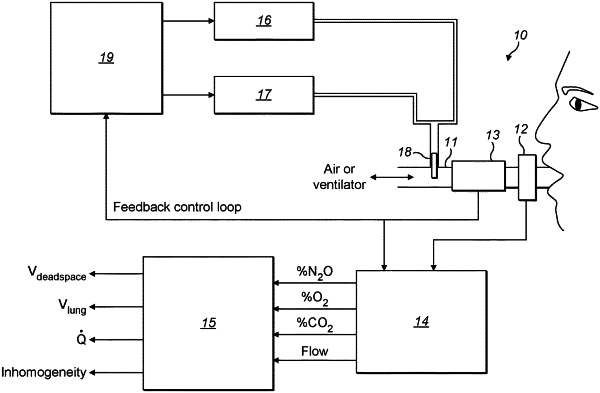| CPC A61B 5/0205 (2013.01) [A61B 5/08 (2013.01); A61B 5/082 (2013.01); A61B 5/7203 (2013.01); A61B 5/7221 (2013.01); A61B 5/7235 (2013.01); A61B 5/087 (2013.01); A61B 5/091 (2013.01)] | 19 Claims |

|
1. A method for adjusting ventilator settings in a ventilated patient based on information obtained by measuring anatomical dead space VD in a lung, the method comprising:
delivering, through a breathing tube a supply of inspired gas, to the ventilated patient for inhalation;
controlling concentration of an indicator gas for inhalation by a mass flow controller to follow a sinewave pattern over successive breaths, by:
injecting the indicator gas into the supply of inspired gas via the breathing tube;
processing a measured flow rate and concentration of the inspired indicator gas over each breath so as to determine, from breath to breath, an injection rate for the inspired indicator gas that will cause the inspired indicator gas to follow the sinewave pattern, and
injecting the indicator gas at the determined injecting rate caused by a feedback control from a gas mixing apparatus, the feedback control based on the measured flow rate, concentration of the inspired indicator gas, the injection rate, the supply of the inspired gas, and feedback from a flow sensor and a gas analyzer each in communication with the breathing tube;
measuring, by the flow sensor and the gas analyzer, the flow rate and concentration of the indicator gas during inspiration and exhalation of the patient;
fitting sinewave envelopes to the measured concentration of the indicator gas over the successive breaths and, from the fitted sinewave envelopes, determining, by a system controller, the inspired concentration FI, the mixed expired concentration FĒ, and the end expired concentration FE with respect to the indicator gas for each breath; and
calculating, by the system controller, the anatomical dead space VD for each of a plurality of inspirations, by:
calculating a tidal volume VT by integrating over time, from the start of a respective inspiration of the plurality of inspirations, the flow rate VT(t) of the inspired gas for the respective inspiration;
calculating a volume of inspired indicator gas in the respective inspiration by integrating over time, from the start to the end of the respective inspiration, the product of an inspired concentration FI and the flow rate VT(t) of inspired gas taken from the concentration and flow rate signals respectively, from the start to the end of the respective inspiration; and
calculating the anatomical dead space VD for the respective inspiration, based on the tidal volume VT for that inspiration; the inspired concentration FI of indicator gas taken from the concentration signal, from the start to the end of that inspiration; a mixed expired concentration FĒ of indicator gas for that inspiration; and an alveolar gas concentration FA for that inspiration defined as the expired concentration FE of indicator gas at the end of that expiration;
the step of calculating comprising a conservation-of-mass principle during expiration, between the amount of indicator gas expired out, the sum of the amount of indicator gas remaining in the dead space, and the amount of indicator gas expired from the part of the lung where gas exchange has taken place, whereby, having determined the inspired concentration FI, the flow rate VT(t), the tidal volume VT, the mixed expired concentration FĒ, and the alveolar gas concentration FA, a mass balance equation is solved to give an estimation of the dead space VD for each breath, wherein said mass balance equation comprises
f(VD)−FA×VD=(FE−FA)×VT;
varying a period of the sinewave pattern of concentration of the indicator gas over successive breaths during use by the patient;
determining, at different sinewave pattern periods, values of one or more of the dead space VD, alveolar volume VA, functional residual capacity, and pulmonary blood flow QP to determine a measurement of lung inhomogeneity based on a variation of the determined values, and
adjusting at least one of tidal volume, positive end expiratory pressure, magnitude, phase, means and period of sinewaves of the indicator gases delivered to the patient based on said measurement of lung inhomogeneity and said determined functional residual capacity, alveolar volume VA, dead space VD, and/or pulmonary blood flow QP.
|